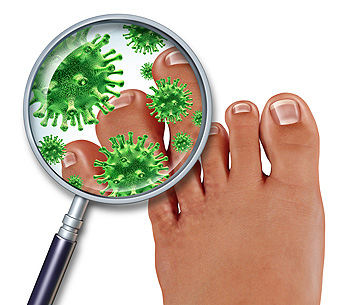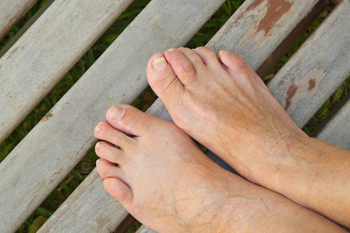 It is important to maintain proper care for your feet, and this may be especially true of the elderly population. Research has shown the natural cushioning in the feet may diminish as the aging process occurs, and the toenails and skin may appear to become dry and brittle. There are several ways to practice good foot care, and these may include looking at your feet closely on a frequent basis, which may aid in noticing any blisters or cuts, wearing footwear that feels comfortable, and performing mild stretches, which may improve circulation. Additionally, washing and drying the feet daily may be helpful in preventing or controlling unpleasant foot odor. If you would like additional information about how to take care of elderly feet, please consult with a podiatrist.
It is important to maintain proper care for your feet, and this may be especially true of the elderly population. Research has shown the natural cushioning in the feet may diminish as the aging process occurs, and the toenails and skin may appear to become dry and brittle. There are several ways to practice good foot care, and these may include looking at your feet closely on a frequent basis, which may aid in noticing any blisters or cuts, wearing footwear that feels comfortable, and performing mild stretches, which may improve circulation. Additionally, washing and drying the feet daily may be helpful in preventing or controlling unpleasant foot odor. If you would like additional information about how to take care of elderly feet, please consult with a podiatrist.
Proper foot care is something many older adults forget to consider. If you have any concerns about your feet and ankles, contact Dr. Barbara Kilkenny from Barbara A. Kilkenny, DPM. Our doctor can provide the care you need to keep you pain-free and on your feet.
The Elderly and Their Feet
As we age we start to notice many changes in our body, but the elder population may not notice them right away. Medical conditions may prevent the elderly to take notice of their foot health right away. Poor vision is a lead contributor to not taking action for the elderly.
Common Conditions
Susceptible Infections
Diabetes and poor circulation can cause general loss of sensitivity over the years, turning a simple cut into a serious issue.
If you have any questions please feel free to contact our office located in Southbury, CT. We offer the newest diagnostic and treatment technologies for all your foot and ankle needs.
Read more about Elderly Foot Care The medical condition that is referred to as athlete’s foot will typically affect many different types of people regardless if they are athletes. The tinea fungus is responsible for this uncomfortable ailment and will survive in moist and warm areas. It is known to be extremely contagious, and it often lives in public pools, showers, and surrounding areas. The noticeable symptoms may include cracked and peeling skin between the toes, dry or raw skin on your feet, or an itchy sensation that may affect the entire foot. There may be pre-existing medical conditions that may include diabetes or a weakened immune system, which can contribute to the onset of athlete’s foot. If you feel you may have developed this ailment, it is suggested to seek the counsel of a podiatrist who can perform a proper diagnosis and correct treatment.
The medical condition that is referred to as athlete’s foot will typically affect many different types of people regardless if they are athletes. The tinea fungus is responsible for this uncomfortable ailment and will survive in moist and warm areas. It is known to be extremely contagious, and it often lives in public pools, showers, and surrounding areas. The noticeable symptoms may include cracked and peeling skin between the toes, dry or raw skin on your feet, or an itchy sensation that may affect the entire foot. There may be pre-existing medical conditions that may include diabetes or a weakened immune system, which can contribute to the onset of athlete’s foot. If you feel you may have developed this ailment, it is suggested to seek the counsel of a podiatrist who can perform a proper diagnosis and correct treatment.
Athlete’s Foot
Athlete’s foot is often an uncomfortable condition to experience. Thankfully, podiatrists specialize in treating athlete’s foot and offer the best treatment options. If you have any questions about athlete’s foot, consult with Dr. Barbara Kilkenny from Barbara A. Kilkenny, DPM. Our doctor will assess your condition and provide you with quality treatment.
What Is Athlete’s Foot?
Tinea pedis, more commonly known as athlete’s foot, is a non-serious and common fungal infection of the foot. Athlete’s foot is contagious and can be contracted by touching someone who has it or infected surfaces. The most common places contaminated by it are public showers, locker rooms, and swimming pools. Once contracted, it grows on feet that are left inside moist, dark, and warm shoes and socks.
Prevention
The most effective ways to prevent athlete’s foot include:
Symptoms
Athlete’s foot initially occurs as a rash between the toes. However, if left undiagnosed, it can spread to the sides and bottom of the feet, toenails, and if touched by hand, the hands themselves. Symptoms include:
Diagnosis and Treatment
Diagnosis is quick and easy. Skin samples will be taken and either viewed under a microscope or sent to a lab for testing. Sometimes, a podiatrist can diagnose it based on simply looking at it. Once confirmed, treatment options include oral and topical antifungal medications.
If you have any questions, please feel free to contact our office located in Southbury, CT. We offer the newest diagnostic and treatment technologies for all your foot care needs.
Read more about How to Deal with Athlete's Foot
 If you notice a sizable bump on the second toe of your foot, you may have what can develop into a hammertoe. Many people experience a bunion first, and this will typically occur on the side of the big toe. As this condition develops, the toes push against each other causing the middle toe to bend downward, and this may cause pain and discomfort. Research has shown this condition may be more apt to develop in people who are experiencing arthritis in the bones of the feet. There may be preventive measures to halt this ailment from happening, including wearing shoes that have adequate room for the toes to move about it in. Moderate relief may be found by performing specific exercises that can stretch the toes. One example would be to try soaking the feet in warm water daily, followed by pointing the toes. This may benefit in stretching the tendons of the toe. If you feel you are developing this condition, please consult with a podiatrist for treatment options that are correct for you.
If you notice a sizable bump on the second toe of your foot, you may have what can develop into a hammertoe. Many people experience a bunion first, and this will typically occur on the side of the big toe. As this condition develops, the toes push against each other causing the middle toe to bend downward, and this may cause pain and discomfort. Research has shown this condition may be more apt to develop in people who are experiencing arthritis in the bones of the feet. There may be preventive measures to halt this ailment from happening, including wearing shoes that have adequate room for the toes to move about it in. Moderate relief may be found by performing specific exercises that can stretch the toes. One example would be to try soaking the feet in warm water daily, followed by pointing the toes. This may benefit in stretching the tendons of the toe. If you feel you are developing this condition, please consult with a podiatrist for treatment options that are correct for you.
Hammertoe
Hammertoes can be a painful condition to live with. For more information, contact Dr. Barbara Kilkenny from Barbara A. Kilkenny, DPM. Our doctor will answer any of your foot- and ankle-related questions.
Hammertoe is a foot deformity that affects the joints of the second, third, fourth, or fifth toes of your feet. It is a painful foot condition in which these toes curl and arch up, which can often lead to pain when wearing footwear.
Symptoms
Causes
Genetics – People who are genetically predisposed to hammertoe are often more susceptible
Arthritis – Because arthritis affects the joints in your toes, further deformities stemming from arthritis can occur
Trauma – Direct trauma to the toes could potentially lead to hammertoe
Ill-fitting shoes – Undue pressure on the front of the toes from ill-fitting shoes can potentially lead to the development of hammertoe
Treatment
Orthotics – Custom made inserts can be used to help relieve pressure placed on the toes and therefore relieve some of the pain associated with it
Medications – Oral medications such as anti-inflammatories or NSAIDs could be used to treat the pain and inflammation hammertoes causes. Injections of corticosteroids are also sometimes used
Surgery – In more severe cases where the hammertoes have become more rigid, foot surgery is a potential option
If you have any questions please contact our office located in Southbury, CT. We offer the newest diagnostic and treatment technologies for all your foot and ankle needs.
Read more about Hammertoe Many people who enjoy running may experience common foot conditions that may be associated with this sport. A portion of the foot that is commonly affected is the the plantar fascia. This is identified as the tissue that is located on the bottom of the foot and connects the heel bone to the toes. If this should become torn or injured, it will most likely produce severe pain and discomfort, and is referred to as plantar fasciitis. A condition known as metatarsalgia may be a result of intense running, and most often affects the middle toes. Patients have equated this discomfort to feeling like there are small stones in their shoes or on the soles of the feet. Additionally, an uncomfortable condition known as Morton’s neuroma may be mistaken with metatarsalgia, but will have additional symptoms that may include burning, tingling, or sharp pains in the toes and surrounding area. It is suggested to consult with a podiatrist if you are experiencing any of these ailments so proper treatment can begin.
Many people who enjoy running may experience common foot conditions that may be associated with this sport. A portion of the foot that is commonly affected is the the plantar fascia. This is identified as the tissue that is located on the bottom of the foot and connects the heel bone to the toes. If this should become torn or injured, it will most likely produce severe pain and discomfort, and is referred to as plantar fasciitis. A condition known as metatarsalgia may be a result of intense running, and most often affects the middle toes. Patients have equated this discomfort to feeling like there are small stones in their shoes or on the soles of the feet. Additionally, an uncomfortable condition known as Morton’s neuroma may be mistaken with metatarsalgia, but will have additional symptoms that may include burning, tingling, or sharp pains in the toes and surrounding area. It is suggested to consult with a podiatrist if you are experiencing any of these ailments so proper treatment can begin.
Foot Pain
Foot pain can be extremely painful and debilitating. If you have a foot pain, consult with Dr. Barbara Kilkenny from Barbara A. Kilkenny, DPM. Our doctor will assess your condition and provide you with quality foot and ankle treatment.
Causes
Foot pain is a very broad condition that could be caused by one or more ailments. The most common include:
Diagnosis
To figure out the cause of foot pain, podiatrists utilize several different methods. This can range from simple visual inspections and sensation tests to X-rays and MRI scans. Prior medical history, family medical history, and any recent physical traumatic events will all be taken into consideration for a proper diagnosis.
Treatment
Treatment depends upon the cause of the foot pain. Whether it is resting, staying off the foot, or having surgery; podiatrists have a number of treatment options available for foot pain.
If you have any questions, please feel free to contact our office located in Southbury, CT. We offer the newest diagnostic and treatment technologies for all your foot care needs.
Read more about Foot Pain